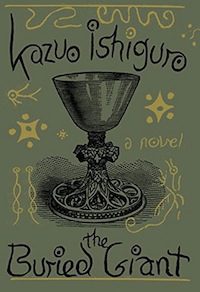
If you were Kazuo Ishiguro, a critically successful novelist in late-middle age, and you knew the qualities for which your readers loved you, would you continue writing in that manner? Or would you want to challenge yourself as a writer, in the hopes that you can continue to grow, and prove to yourself that late-middle age does not represent the beginning of the end?
This is what Ishiguro has done with his long-awaited new novel The Buried Giant. Ishiguro, who turned sixty last year, has made a name for himself with his touching portraits of loss. In the Man Booker-winning The Remains of the Day, a stiff English butler recalls a romance that almost was and the glory days of his manor house. In the popular Never Let Me Go, a clone named Cathy remembers her love, another clone named Tommy. Clones and English butlers may seem like wildly different topics, but these novels share the same crucial animating element: yearning for the past.
So when I began to read The Buried Giant, a novel that follows the journey of a medieval couple named Axl and Beatrice, I was not surprised that Ishiguro had jumped to entirely new time period: post-Roman Britain. I was surprised, however, when I was introduced to two main characters who have trouble remembering days past. But viewed through the lens of Ishiguro’s personal development, his choice makes sense: the forgetfulness of the main characters in The Buried Giant presents an interesting challenge for the author, because while his two most famous novels dwelled in the past, his new one must be placed almost exclusively in the main character’s present.
And that present is a lively one, once Axl and Beatrice finally get going on their journey to visit their son, who maybe might live in a village a couple days walk away but they’re not really sure. (But, to be fair, Axl and Beatrice don’t talk in this tone of voice. Their speech is in fact so formal it feels stilted at times.) Along the way they meet a mysterious boatman, a woman who likes to slit rabbits’ throats, and a village full of terrified Saxons—ogres took some of their men. They encounter a dragon named Querig and the Arthurian Sir Gawain. They make new friends: a knight named Wistan and a precocious little boy named Edwin.
It turns out that their forgetfulness is not the result of God’s wrath, as the characters once thought, though I won’t say more than that. But perhaps forgetfulness isn’t solely a weakness. If loss caused love to strengthen and remain strong in Ishiguro’s previous novels, perhaps forgetfulness has done the same in the case of Axl and Beatrice. When Axl and Beatrice’s love for one another is put to the test in the final pages of the books, they themselves wonder if their forgetfulness was more of a gift than a curse.
“I was wondering, princess,” Axl says to Beatrice. “Could it be our love would never have grown so strong down the years had the mist not robbed us the way it did? Perhaps it allowed old wounds to heal.” It’s an interesting idea. But it’s not an idea that’s strong enough to animate the novel in the same way that lost love animates his others, which are, ultimately, more powerful than The Buried Giant.
This is not to say that The Buried Giant is a book without merit. It is a carefully crafted and, most importantly, believable fantasy novel in the vein of Lord of the Rings. But do not come to this novel looking for an iteration of Ishiguro’s previous works. You won’t find it here.





